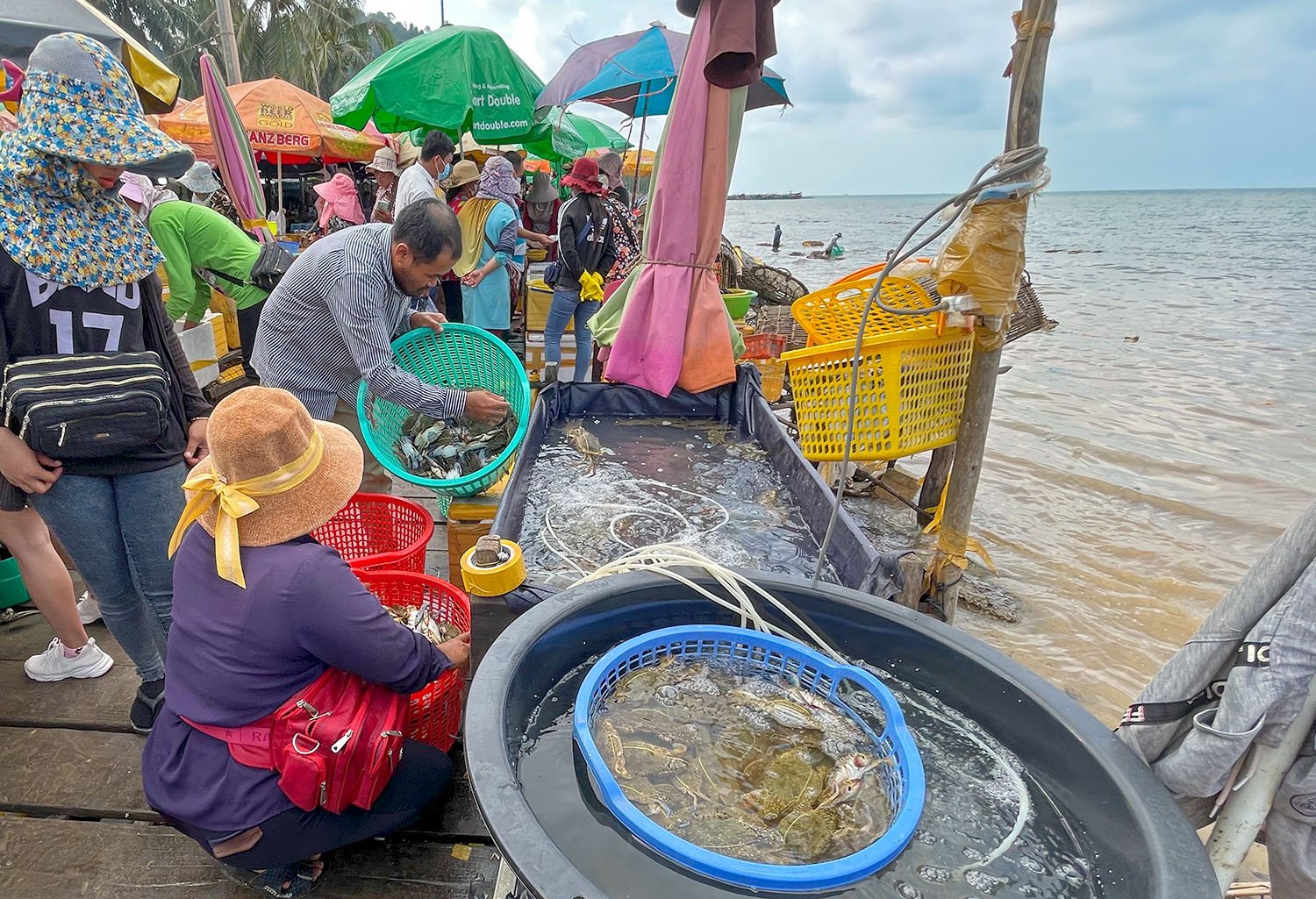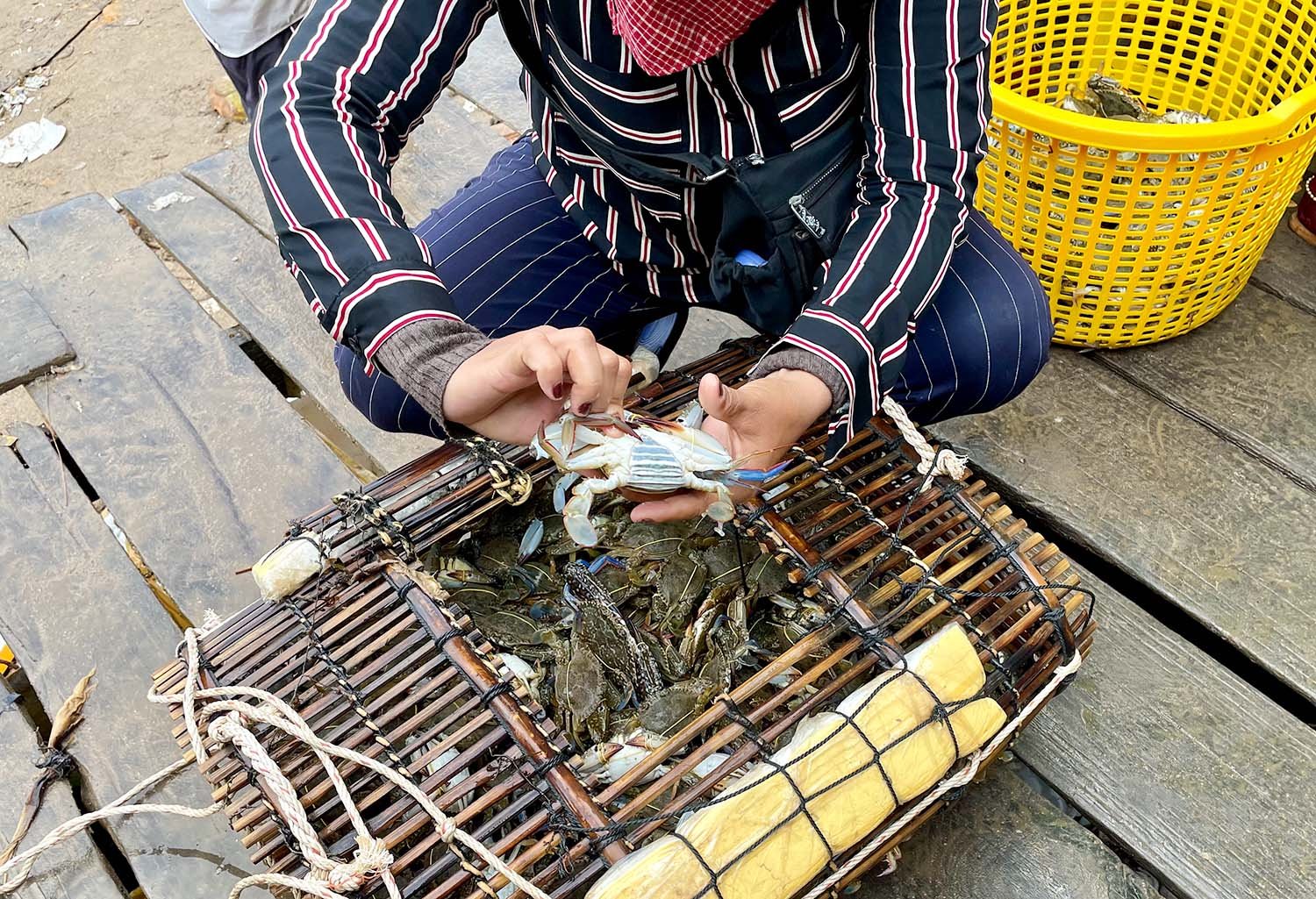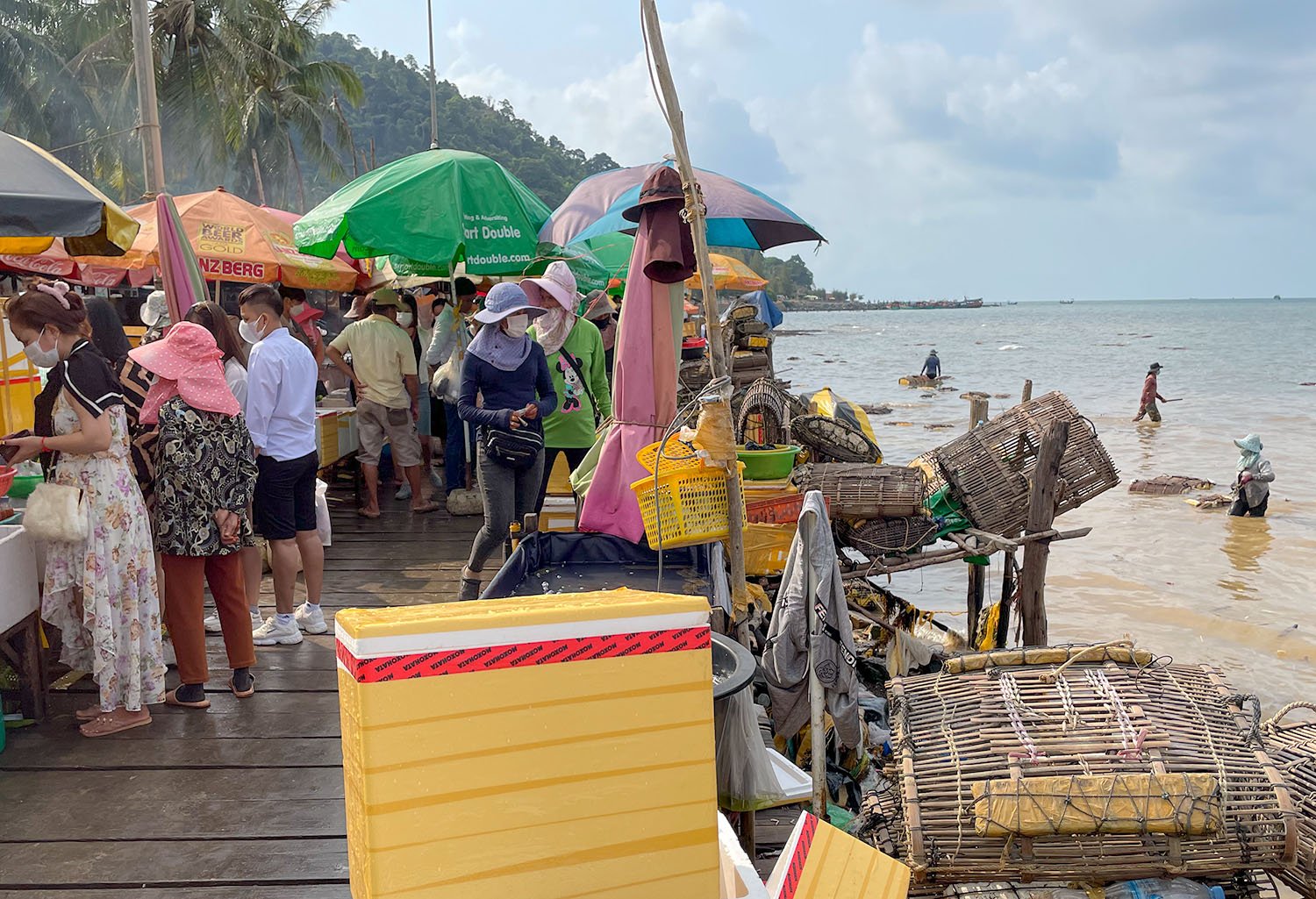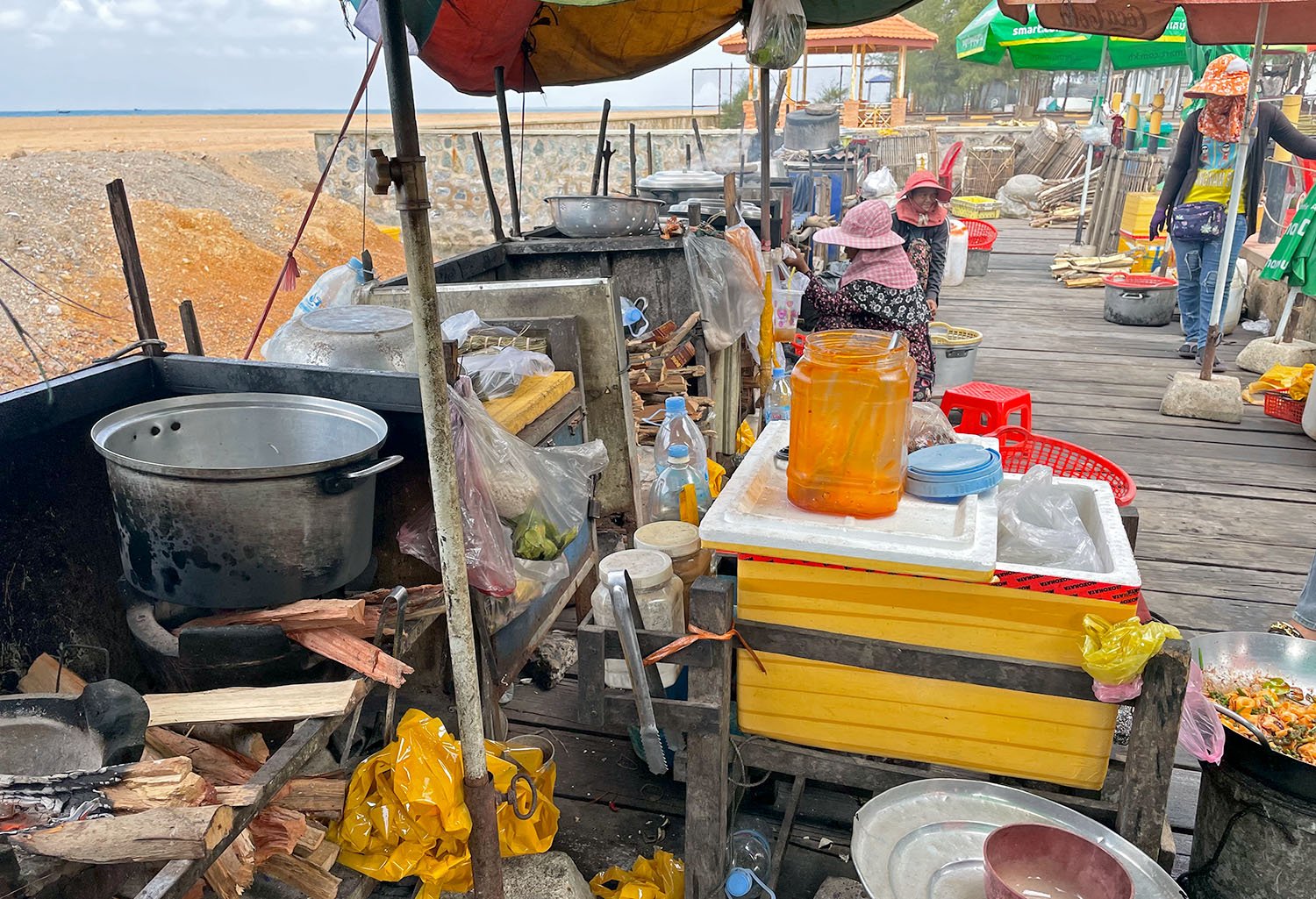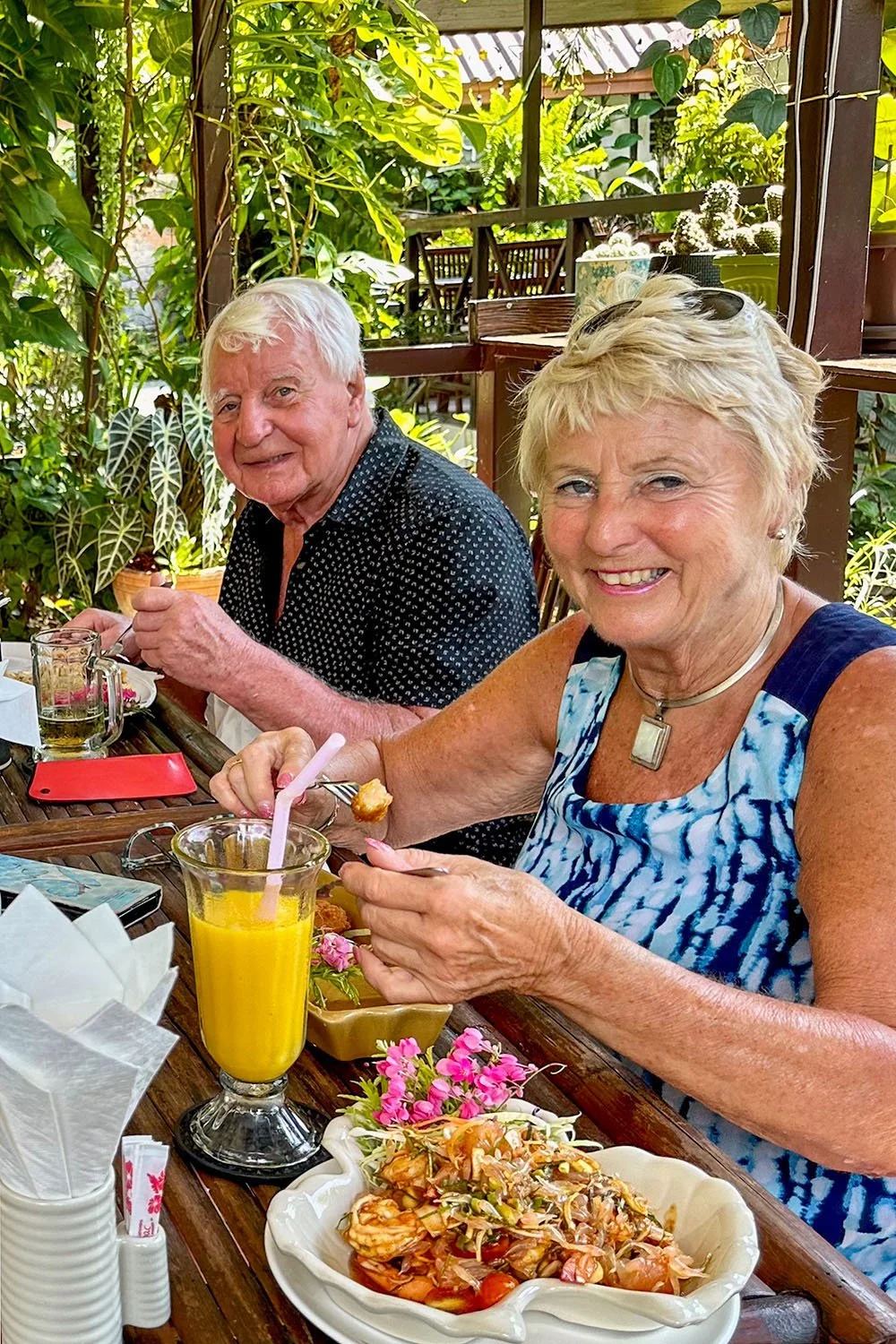Kampot: More Than Just a Destination for Foodies
Kampot is a laidback town on the Tuek Chhu River in southern Cambodia. With a backdrop of the 1000m high Bokor Mountain to the northwest of the town, and its old French colonial buildings, it’s a picturesque location that has attracted several thousand expats and retirees from the UK and northern Europe looking for a quiet life in rural Cambodia.
Some of those expats partnered with locals and opened restaurants featuring continental fare, complementing the many eating places already established by Cambodian citizens. Kampot has long been known as the source of some of the most flavourful pepper in the world, with the best French chefs using Kampot pepper as far back as the 17th century.
In more modern times, Kampot had established itself as a popular lunch stop for those travelling from Phnom Penh to Sihanoukville on Route 3, and in recent years the expansion of the restaurant scene has resulted in the town gaining something of a reputation as a destination for foodies.
And that reputation is well deserved, as I found out on a recent visit to the province. I also discovered that there’s a lot more to see and do in and around Kampot than just eating your way through the local menus. I booked for four nights and would consider that to be the minimum length of stay to sample Kampot’s best experiences without rushing.
Picturesque Kampot on the Tuek Chhu River.
With three full days at your disposal, you’ll be able to get to know your way around the town and see some of the local sights, take a trip up to the Preah Monivong Bokor National Park and the old French hill station on Bokor Mountain, visit one of the nearby pepper plantations, and do a day trip to Kep, the crab capital of Cambodia, further down the coast towards the Vietnam border.
Of course, if you are travelling on a tighter itinerary, you could probably cram those trips into two days, but that doesn’t fit so well with the relaxing ambiance of Kampot and won’t give you as much time to try the many different eateries. Kampot is very much one of those places that fits a ‘slow travel’ itinerary where you take the time to enjoy the slower pace of life of the locals.
I arrived in Kampot early afternoon after a three-hour private taxi ride from Phnom Penh. That cost me US$55 and we probably would have made it in under three hours if not for the traffic jams leaving the capital. I dropped off my bags at my pre-booked accommodation on Fish Island and then headed back over the river in a tuk-tuk ($2) for a late lunch.
I had the tuk-tuk driver drop me off at the Epic Arts Café in the centre of Kampot as I thought that would be a good base from which to explore the town after lunch. The streets at lunchtime were surprisingly quiet with few tourists around. Most of the people in the cafes and restaurants at that time of the day were older expats.
Some of lunch menu items on the Epic Arts Café website.
The Epic Arts Café is a social enterprise established by a British NGO and profits from the café are used to support education and community projects for disabled persons in the Kampot region. It has an excellent lunch menu of western and local food, good coffee, and a wide range of drinks. Prices are very reasonable so it’s well worth your support.
After lunch I strolled around the town to check out the location of other cafes and restaurants that I planned to visit, and to see what other places may be worth a look. Most of the better eating places are located along the eastern side of the river between the Entanou Bridge (the old steel bridge across the river that is restricted to tuk-tuks and motorbikes) and the Rikitikitavi Hotel five blocks south.
Most of the upmarket restaurants are located in old French colonial buildings that have been renovated and repainted. A couple offer French cuisine, and there are Italian, Indian, Chinese, Swiss and Mediterranean restaurants, and others that are best described as Cambodian/international fusion. Many of the restaurants and bistros include dishes on their menus that feature Kampot pepper.
The restaurant district extends 2-3 blocks back from the river, and within this area there are quite a few bars, massage places, local shops and tourist shops. The bars include both regular bars and a few small hostess bars, but it was mainly the regular bars that were full in the evening. One of the most popular is the Oh Neil’s Irish pub on the river which is managed by a Irishman and has an Irish barmaid.
The Oh Neil’s Irish pub down by the river.
I dropped by Oh Neil’s to try a glass of the famed Kampot cider, but the owner told me that the brewery producing the cider had closed down during the Covid pandemic and was not expected to reopen. The cider brewery was not the only casualty of the pandemic. Several of the restaurants previously listed amongst the best in Kampot, including the top-rated Barada, have closed permanently.
Aside from the restaurant district in the centre of town, there are many eating places in the riverside resorts upstream and downstream from the town. Some of those are in upmarket resorts where restaurant prices are on a par with the restaurant district in town, but the majority are budget resorts where prices are much cheaper, but from all reports providing good food at exceptionally low prices – so plenty of options for budget travellers.
I didn’t get time to try any of the riverside resorts for lunch or dinner, because I focused on the restaurant district in town, but I intend to check out those on a future visit. Most of them are an easy tuk-tuk ride from the centre of town, which shouldn’t cost you more than $2.
I don’t recommend the restaurant boats that are parked on the western side of the river (opposite the restaurant district in town) as they serve only basic Cambodian food, beer and hard liquor. Once they’ve filled a certain number of tables, they start cruising up and down the river playing loud Cambodian pop music. They won’t appeal to most older travellers.
The stylish Atelier restaurant facing the riverside.
For my dinner on the first night, I headed to Atelier on the riverside, a few doors up from the Irish pub, as I liked the look of their menu which I had browsed during my walk around the town in the afternoon. Atelier’s full name is ‘Atelier 1945 Kampot Pepper Artisans’ and describes itself as a gourmet bistro that “blends French bistro cuisine with modern approaches to traditional Asian dishes”.
The restaurant is housed in two beautifully restored shophouses and uses as many locally grown ingredients as practical, including the famed Kampot peppers. Many of the dishes have been created specifically to showcase the different pepper aromas.
I started with their seasonal vegetable gazpacho accompanied by a glass of ‘Seekers Negroni’ (dry gin, campari and sweet vermouth) followed by their Kampot pepper and lime-marinated chicken skewers with baked sweet potatoes. The food was superb. I was intending to try the lime curd pie for dessert but was too full to eat anything more after my first two courses. I finished instead with a glass of ‘Seekers Smash’ (dry gin, lime juice, sugar syrup and Khmer basil) which was very refreshing.
Meat lovers will surely love their Cambodian beef filet with olive oil mashed potatoes, fresh vegetables and Kampot black pepper sauce, and fish lovers should be tempted by their meuniere sea bass with Kampot red pepper and mashed carrots, or Kep crab cannelloni with green pepper and side salad. There are several interesting vegetarian dishes on the menu as well, and lighter fare for lunch.
The delicious prawn dumplings at Atelier.
The next day I returned to Atelier for lunch to try their prawn dumplings in a white pepper broth with bok choy and Enoki mushrooms. The prawns were deliciously fresh, and the pepper did not overpower the delicate flavour of the dumplings. I was going to finish with the lime curd pie that I’d had my eye on the night before, but it wasn’t available that day, so I went around the corner to the Kampot Pie and Ice Cream Palace and had their lemon pie with homemade ice cream instead.
The Kampot Pie and Ice Cream Palace does a great chicken curry pie too, and I also tried their apple and cherry pies during the three and a half days that I was there. I think that place was responsible for adding at least an inch to my waistline.
After lunch I noticed that the clouds had cleared from the top of Bokor Mountain, so I hired a PassApp for the one-hour trip up the mountain. In Cambodia, the three-wheeled motorised tricycles that are known as auto rickshaws in India, are commonly called PassApps after the phone app that is used to book them (but you can also hail them off the street).
The local tuk tuks (motorbikes with a two-wheeled trailer behind them) are not powerful enough to make it up the mountain, so the only options to go up to the national park (if you are not driving yourself) is to hire a PassApp, a motorbike or scooter, or a car with a driver. I agreed a price of $25 with my PassApp driver for the return trip with two hours on the mountain.
The Lok Yeay Mao monument on Bokor Mountain.
The road up the mountain is one of the best I’ve been on in Cambodia. It’s a well-maintained scenic winding road and you’ll see many monkeys in the trees on the way up (and sometimes on the road). When you reach the plateau at the top, you can pull off the road at the Lok Yeay Mao monument, a large Buddha statue, for your first views out over the ocean towards Phu Quoc island in Vietnam.
It's another 15 minutes or so along an undulating road to reach Wat Sampov Pram from where you’ll have even more expansive views out to the ocean. On the way you’ll pass the Thansor Sokha Hotel, a large so-called 5-star casino resort that was built in 2012 but from the outside looks much older. Many people who have stayed there complain it is badly maintained, often empty, and the food and service are poor. It looks very out of place in a national park.
Wat Sampov Pram itself is an interesting collection of old temple buildings including a working monastery that is perched on top of a cliff face overlooking the Gulf of Thailand. There are many excellent viewpoints in and around the monastery, but there are no guard rails in most places, so be careful where you walk.
Walking tours can be arranged for those who wish to do some hiking at the cooler elevations of Bokor Mountain. It is not advisable to walk on your own as there are big cats in these mountains, although they usually stay much deeper in the national park and away from the temple area. If on a walking tour, always stay on the tracks that your guide takes as there may still be landmines in the jungle.
The view from Wat Sampov Pram on Bokor Mountain.
Back in Kampot that evening, I tried the Fish Market restaurant down on the river not far from the Entanou Bridge. The building which houses the restaurant was indeed a fish market from the early 1900s through to about 1950, after which it was turned into a radio station for about 20 years. Then during the dark period of Cambodia’s history, it was taken over as a police station.
The restaurant’s interesting history didn’t stop there. After the liberation of Cambodia, the building was used as a Customs House for about 20 years, and then turned into a Chinese restaurant. In 2008 it was converted into a nightclub called ‘Alaska’, and finally in 2012 was painstakingly restored to its original condition to become a seafood restaurant.
It’s one of Kampot’s iconic restaurants and I ordered snapper cooked in a ginger, shallot and honey sauce. It was a tasty dish, and the fish was cooked perfectly, but regrettably my dining experience was spoiled by noisy children running around the restaurant unsupervised, and diners at the next table smoking throughout their meal (a common problem in Cambodian restaurants).
On my second full day in Kampot, I hired a tuk-tuk to take me out to La Plantation – one of the pepper plantations near the town that is open to visitors. La Plantation has a small visitor centre with a restaurant and provides free tours of the plantation with a guide who will explain how the pepper is grown and processed.
La Plantation’s visitor centre and restaurant.
If you’ve not heard about the international reputation of Kampot pepper, then check out this article which explains why it is much sought after by chefs around the world. Once you know a little about the history of Kampot pepper, you’ll have a better understanding why nearly every restaurant in Kampot features dishes with the local pepper on their menus.
The trip out to La Plantation is mostly along dirt roads which can be quite dusty in the dry season, but it’s an interesting 40 mins trip through rural villages and past rice fields lined with cabbage tree palms. The tuk-tuk drivers are happy to wait for however long you want to spend at the plantation, so you won’t have to worry about finding transportation back into town.
I was the first visitor to arrive for the day and they suggested that I take a buffalo cart ride down to a nearby lake whilst waiting for the guide to prepare for the first tour (I don’t think they wanted to do a tour for one person). Normally I wouldn’t bother with buffalo cart rides because they are slow and uncomfortable, but I said yes because I wanted to have a closer look at the lake.
The buffalo cart ride to the nearby lake at La Plantation.
I’m glad I did, because the buffalo cart driver took the cart right out into the shallow lake to give the buffalo a wash, and it was a much more interesting experience than the usual touristy buffalo rides that are offered in Southeast Asia. By the time I arrived back at the visitor centre, about a dozen other people had arrived, and they were sampling some of the health drinks on the restaurant menu.
I joined them, ordering a butterfly tea flower limeade, which according to the menu would help improve my brain health and skin. (Later, with lunch, I tried the ginger lemongrass limeade which was very refreshing). After finishing our mid-morning drinks, we set off on the tour of the plantation to learn more about Kampot pepper, and our knowledgeable guide did an excellent job fielding many questions from the group of visitors.
After the tour it was time for lunch, and I was urged to try their house speciality – the Lok Lak beef with black, red and white Kampot peppers. I don’t often eat red meat, but I enjoyed this dish because the beef was tender, having been sliced and marinated, and then sauteed with garlic, palm sugar, soy sauce, fresh tomatoes and, of course, the three Kampot peppers. A vegetarian version of Lok Lak uses eggplant instead of beef.
When I got back to Kampot, I decided to try a durian iced coffee as I’d passed by a durian coffee booth at the end of the Entanou Bridge several times, and I was intrigued about what it would taste like. I’m not a big fan of durian, but don’t mind the flavour of durian ice cream and durian cake. However, the durian iced coffee, which comprised lumps of fresh durian stirred into a regular iced coffee, was not to my taste.
The durian coffee booth down on the riverside.
Later that afternoon the owner of the bungalows where I was staying on Fish Island gave me a free tour in his tuk-tuk out to the salt pans on the southwestern side of Fish Island. Kampot salt is not as sought after as Kampot pepper, but it was interesting to see close up how it is produced in these parts.
On the way back to the bungalows we chatted about what else there was to see and do around Kampot, and he told me about the luminous plankton that can be seen at night around the mangroves near the mouth of the Tuek Chhu River. I asked about how I could get to see those, and he said he could organise a fishing boat for a private sunset trip down the river for US$35.
He said there were some other guests staying at the bungalows who were interested to make the trip the following evening, so if I went with them, we could share the costs. I confirmed that I would like to join them, and then headed into town for dinner.
I had already decided I would eat at Kampot Seafood & Pepper, one block back from the riverside, because I had checked out their extensive menu on one of my walks around town and was looking forward to trying one of their slipper lobster dishes. I chose the one with citrus sauce, coco beans mousseline and fresh orange supreme, and for $12 it was a very generous serve of three lobsters.
My slipper lobster dish at Kampot Seafood & Pepper.
The restaurant is larger than Atelier and is located in one of the most impressive renovated colonial buildings that I visited in Kampot. It has a lovely ambience spoiled only by the rows of motorcycles parked outside (making it difficult to take a good photograph of the restaurant).
You’d need a couple of weeks to go through everything on the menu at Kampot Seafood and Pepper. They have an interesting cocktail menu too, including a green pepper mojito, with all cocktails priced at just $5. The restaurant also offers three-hour cooking classes in the morning and afternoon for $20.
The next day I set out to sample more local seafood by hiring a tuk-tuk to take me down to Kep, about 25 km down the coast towards the Vietnam border. Kep is known as the ‘crab capital’ of Cambodia and has a lively seafood market where you can buy fresh crabs straight out of the pots and have them cooked while you wait for only a couple of dollars.
Alternatively, you can head to one of the sit-down restaurants nearby such as the Crab Kitchen, Holy Crab or Kep Sur Mer for a seafood meal with accompaniments. You’ll pay a lot more there than having your crabs cooked at the market, but the experience will be more enjoyable than eating your crabs out of a plastic bag.
Photo gallery: The busy and somewhat chaotic Kep crab market:
The crab market is on a section of the coast that faces west. A little over a kilometre further on, the road does a left hand turn around a forested headland and you’ll find yourself in a picturesque south-facing cove with a yellow sandy beach. This is Kep Beach – the most popular swimming beach in this part of Cambodia. It can become very crowded at weekends.
You can hire beach umbrellas and chairs if you would like to sit on the sand, but most people sit under the shade of the large sea almond trees that line the road or the small marquees that are set up between the road and the beach. Many of the marquees have colourful mats, lounge chairs and hammocks and are popular with locals for family picnics.
Behind Kep Beach is a forested hill that is the Kep National Park. It’s not a large park (about 60 sq km) but there is an 8 km walking trail through virgin jungle around the mountain with lookouts from where you’ll have excellent views of Kep town and across to Phu Quoc island in Vietnam.
The National Park has long been one of the three main drawcards of Kep, along with the crab market and the beach. But when I headed there after lunch, looking forward to doing the jungle hike, I discovered a road was being built up the mountain, destroying much of the pristine jungle in the process.
The clean yellow sand of Kep Beach.
I was not able to find out why the road was being built. Someone suggested developers were planning a luxury resort on the hillside, but there were no signs to confirm that. I did not do the hike because I was informed that there had been reports of troops of monkeys attacking visitors – something that hadn’t occurred before but was possibly happening now because the road builders had disturbed their habitat.
Later that afternoon, back in Kampot, I joined the other travellers from the bungalows for the boat trip down the Tuek Chhu River. We followed about 20 fishing boats which were heading out into the Gulf of Thailand for the night. A few tourists were kayaking in front of a luxury glamping resort and several speedboats passed us taking tourists on joyrides.
The river trip turned out to be one of the highlights of my stay in Kampot. Not because of the luminous plankton (which turned out to be somewhat underwhelming) but because when we reached the mouth of the river, the boatman let us off on a sand spit from which we saw one of the most beautiful tropical sunsets that I’d seen for many years.
And on our way back in the dark, as the boatman was shining his powerful torch on the surface of the river, hundreds of fish were jumping from the water and following us back up the river. It was a fascinating back-to-nature experience. We stopped briefly at the mouth of a river tributary to see the plankton in the slower moving water around the mangroves and saw fireflies there as well.
After the exhilaration of the river trip, I felt like some ‘comfort food’ rather than haute cuisine, so headed to the Rikitikitavi Hotel and ordered a Chicken Ryder on the recommendation of one of the other travellers from the river trip. It was stuffed with Kampot pepper ham, Emmental cheese and cashew nuts, and was served with a delicious mushroom sauce and perfectly cooked fresh vegetables. The price was $8.50. I had a glass of Vina Maipo (a Chilean Sauvignon Blanc Chardonnay blend) for $4 with the meal.
Hard liquor drinkers may be interested to know that the Rikitikitavi has a very extensive menu of spirits from all over the world including about a dozen single malts from Scotland. There’s also a good cocktail menu too including a Kampot Mary, which is a twist on the traditional Bloody Mary with the addition of tamarind juice and a dash of Kampot pepper.
I left Kampot the next day with the feeling that I’d only scraped the surface of what this town has to offer to those who enjoy good food. Most restaurant prices are about half what comparable places in Phnom Penh would charge and about a quarter of what you would expect to pay in larger Asian cities like Singapore.
If you enjoy Khmer food, then eating in the many local restaurants is even cheaper. It’s little wonder that so many European retirees have made Kampot their home, and it’s easy to see why the town of Kampot has become a destination for foodies. But even if you don’t regard yourself as a foodie, the province of Kampot has a lot to offer those who enjoy nature and a safe rural destination for relaxation.
All images (except Epic Arts Cafe menu items): © David Astley


